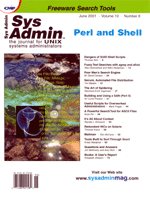 New
Messages New
Messages
From: Yat Chow <yatchow@hotmail.com>
To: brd@hccsonline.com; kwurl@us.ibm.com
Subject: Sys Admin article -- ufsdump
I am writing in regard to your article, "Quick and Dirty
Server/Workstation Replication Using ufsdump", in the Sys
Admin April 2001 issue.
1. On Step 2 - Step 3, you called for installation of Solaris
OS (only to be erased later). You can save yourself a lot of time
by booting it off the CD in single user mode:
boot cdrom -sw
Then, use format command to partition your drive. This will
achieve the same result in less than 5 min.
2. After Step 4, you will need to install the boot block or the
system won't boot up. Mount the /usr partition that
you have just restored:
# mount /dev/dsk/c0t0d0s2 /a
# cd /a/platform/`uname -i`/lib/fs/ufs
# installlboot ./bootblk /dev/rdsk/c0t0d0s0
This will place the bootblock at the beginning of the drive c0t0d0s0.
3. On Step 5, you said setenv boot-command disk0, I am
not sure if that's what you want to do. Should it be:
setenv boot-device disk0
"boot-command" is just what the parameter does; it
is the command it will execute upon booting up. Then "boot-device"
is the device it will boot from. So, during boot up, it will do:
boot disk0
<Boot-command> <boot-devices> <option>
4. A very important thing to remember about cloning systems (if the
two systems are different hardware) is the architecture of the systems.
Do uname -i to find out the architecture. of your system. You
cannot clone systems on different architecture machines. Believe me,
I tried many times without success. Most of the new Sun system are
"sun4u" architecture, only old systems are "sun4m".
So, this is one thing that might cause the system to fail to boot
up.
Yours, Yat (Calvin) Chow
To: "'Yat Chow'" <yatchow@hotmail.com>,
kwurl@us.ibm.com
Subject: RE: Sys Admin article -- ufsdump
Dear Mr. Chow:
Thanks for the careful read of our article. In reply to your comments:
1. You are correct about saving time to boot from the CD and use
format. Our first draft of this article did just that. But
it was very difficult to explain how to use format to set
up the disk partitions, especially when the disk sizes are not the
same between the original and clone systems. We spent two paragraphs
alone explaining what "Free Hog partition" meant. We decided
that rather than confuse readers with the various partitioning options
that Sun's format command uses, we would make it very
easy by using the install "boot cdrom - install"
command and have the reader fill in the graphical partition table.
Granted, this takes about 15 minutes extra to load the system up
just to overwrite it later, but it saves many headaches.
2. If you use the format command as you recommend, you
would have to install the boot. But using our method, the Solaris
install CD puts the boot block in for you as part of its built-in
installation script. Thus, the reader will not have to perform this
step. I've successfully done this on many systems here in-house.
3. You write: "On Step 5, you said setenv boot-command
disk0, I am not sure if that's what you want to do. Should
it be:"
setenv boot-device disk0
You make a great point here. And I agree wholeheartedly, which is
why we added the caveat at the end of the article that: "Cloning
works best if the clone machine has the same hardware as the original
machine ..." Perhaps we should have stated our point a bit more.
Again, thanks for your comments. We really appreciate them. It
just goes to show that there are many ways to perform a given task.
Sincerely,
Ben Diamond
brd@hccsonline.com
I also received some letters in support of James O'Gorman's
script title (April issue). Here's a sample:
From: Gary Luther (gluther@safmt.org)
Subject: Viagra: Keeping Services Running on BSD (Feb 2001)
I am writing to support James O'Gorman and his article. Victoria
Sadoff wrote chastizing his reference to penises. Since I didn't
think such a reference would make it past the editing table, I reread
the article several times to see if perhaps I had become jaded in
what was acceptable. I found the use of the word Viagra 6 times
including the title and the program listing. Since it was the name
of the script (clearly the author's choice), James made reference
to his admittedly plagiarized script only 4 times. Nowhere in the
article was there a direct reference to penis(es). Not wanting to
be offensive -- perhaps James could rename his script BobDole.
Thanks to all for writing. I appreciate the comments on both sides.
In regard to the script name, our editorial staff did not find the
Viagra name offensive, but we cannot anticipate every reader's
reaction. We hope to maintain a balance of (tasteful) humor and technical
information.
I appreciate your time and your support of the magazine.
Best Regards,
Amber Ankerholz
aankerholz@cmp.com
|

